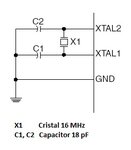Bish00
Newbie level 4
Hi,
I'm new to this forum but I have been following it for a while and received good advices . Now I need help, since I think I messed up fuse bits
. Now I need help, since I think I messed up fuse bits  . So here's my problem:
. So here's my problem:
I have ATMEGA328-PU microcontroller and I use WinAVR and AVRDude to change fuse bits. Before I did fuse bits change, the default values were following: lfuse: 0x62, hfuse: 0xd9, efuse:0xff. What I did was that I changed fuse bits to following settings: lfuse: 0x60, hfuse: 0xd9, efuse:0xff. Now I get famous error "initialization failed rc=-1". I use usbtiny and I have tried to find solution for this problem from ladyada.net but no solutions. They tell there that just check your connections, well I have tried to check and they are correct.
Then I used other microcontroller but exactly the same model and reading fuse bits and everything else is working. However I didn't to try to write fuse bits with this new microcontroller, but the thing is that it worked and that other didn't worked. Then I saw in this forum solution where I have to put oscillator of 4 Mhz, not crystal oscillator, erase the chip and reprogram fuse bits. This didn't help either. Any solution for this?
I'm new to this forum but I have been following it for a while and received good advices
I have ATMEGA328-PU microcontroller and I use WinAVR and AVRDude to change fuse bits. Before I did fuse bits change, the default values were following: lfuse: 0x62, hfuse: 0xd9, efuse:0xff. What I did was that I changed fuse bits to following settings: lfuse: 0x60, hfuse: 0xd9, efuse:0xff. Now I get famous error "initialization failed rc=-1". I use usbtiny and I have tried to find solution for this problem from ladyada.net but no solutions. They tell there that just check your connections, well I have tried to check and they are correct.
Then I used other microcontroller but exactly the same model and reading fuse bits and everything else is working. However I didn't to try to write fuse bits with this new microcontroller, but the thing is that it worked and that other didn't worked. Then I saw in this forum solution where I have to put oscillator of 4 Mhz, not crystal oscillator, erase the chip and reprogram fuse bits. This didn't help either. Any solution for this?
